In this tutorial you will be given the following:
- An explanation of what matrices IQ tests are and how they are used
- A tutorial on strategies to solve Advanced Raven Matrices Test problems, with examples
- A link to the original Raven Progressive Matrices test – so you can test yourself
- Links to additional Matrices Test resources
Matrices IQ Tests
A matrices test is a non-verbal ‘culture fair’ multiple choice IQ test, that measures your fluid intelligence (Gf) – your reasoning and problem solving ability. Fluid intelligence is a core component of g – your general intelligence.
In each test item, the subject is asked to identify the missing element that completes a pattern of shapes. The patterns are presented in the form of a 4×4, 3×3, or 2×2 matrix, giving the test its name. An example of a matrices test is shown here, from Smart-kit.com.
Because of the simplicity of their use and interpretation, and their independence of language and reading and writing skills, Matrices tests have widespread practical use – as a measure of intelligence in the general population for both adults and children, for job applicants as a psychometric test, for applicants to the armed forces, and for assessing clinical (e.g. Autism) populations.
Strategies To Get A High Score On A Matrices Test
Each Raven test has the same format: a 3 x 3 matrix in which the bottom right entry is missing, and must be selected from 8 alternatives.
Solving Raven’s matrices type problems essentially requires figuring out the underlying rules that explain the progression of shapes.
Here is an example to try to figure out:
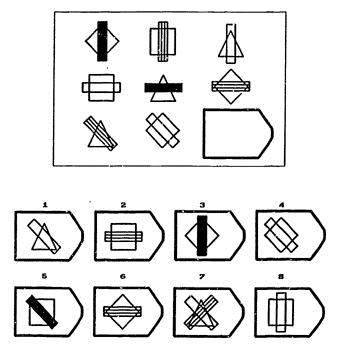
The correct answer is 5. The variations of the entries in the rows and columns of this problem can be explained by 3 rules.
1. Each row contains 3 shapes (triangle, square, diamond).
2. Each row has 3 bars (black, striped, clear).
3. The orientation of each bar is the same within a row, but varies from row to row (vertical, horizontal, diagonal).
From these 3 rules, the answer can be inferred (5).
5 Rules For Matrices Problem Solving (Advanced Matrices Test)
John Raven designed all the problems for his Advanced Matrices test to be based on five basic types of rule. Each problem might have combinations of different rules or different instances of the same rule.
In order to solve Advanced Raven Matrices Test problems effectively, you will benefit from learning some rules.
These are the rules:
1. Constant in a row. This is ‘rule 3’ in the matrix example above – the orientation of the bar is the same in each row, but changes down a column.
2. Quantitative progression. An increase or decrease between adjacent entries in size, position or number. An example of this rule is shown below:
The correct answer is 3. The number of black squares in each entry increases in the top row from 1 to 2 to 3. Similarly, the number of black squares in the first column decreases from 3 to 2 to 1.
3. Figure addition or subtraction. A figure from one column is added to or subtracted from another column to produce the third. An example is given below:
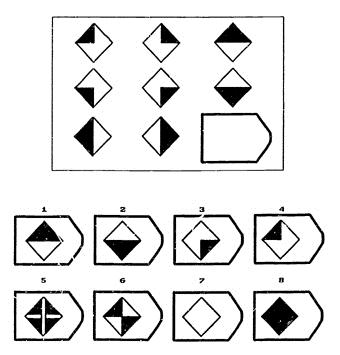
Correct answer 8
4. Distribution of 3 values. Three values of a category such as shape are always present in each row. Two examples of this rule are shown in the first matrix we looked at above. Each row contains 3 shapes (triangle, square, diamond), and each row has 3 bars (black, striped, clear).
5. Distribution of 2 values. Two values of a category such as shape are always present in each row, but the third is null/irrelevant. An example of this is given below.
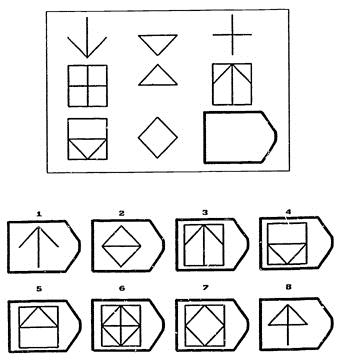
The correct answer is 5. Each figure element (horizontal line, vertical line, V shape) occurs two times in each row.
Finding Corresponding Elements
In problems with more than one rule, the problem solver must figure out which elements in the puzzle are governed by the same rule – something that can be called ‘correspondence finding’.
An example of a correspondence problem is shown below:
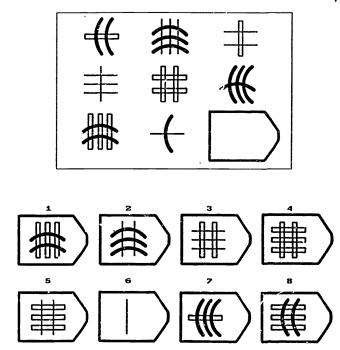
The correct answer is 5. Figuring out what corresponds to what requires that you form hypotheses in your mind and test them out. A hypothesis is an imagined explanation or prediction that needs to be tested.
In the example above, one hypothesis is that one rule applies to the bars, another rule applies to the dark curves, and another rule applies to the straight lines. Although it’s true that each column has two of each type of shape, this hypothesis doesn’t explain the number of the different elements. Another hypothesis is needed. Orientation (vertical or horizontal) can be the basis of the rules needed to solve this problem. In each row there are always 1, 2 and 3 horizontal elements and 1,2 and 3 vertical elements. In addition to this, 1,2 and 3 elements of each shape are distributed across the three rows.
Additional Training Resources
Alternative Matrices tests based on Raven’s test and using similar principles can be found here (Italian text – the site is safe). To get your results after taking either test, you need to enter your age in the box provided and then click on ‘IQ’.
SimilarMinds Matrices Test – scored.
An evidence-based cognitive training app for increasing IQ and Matrices test scores is i3 Mindware.

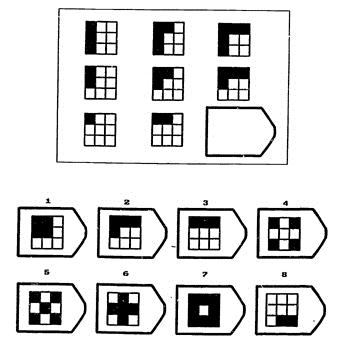
This is a very nice tutorial! Breaking the matrix down for me (wish I had done that myself) took me by the hand. My stars! Great and thanks! I want more tutorials. Kate
I have seen alot of raven matrices that seem to to me to go by rules of symmetry, movement (e.g. clockwise/sideways) or where some figures work as a function for other figures. I’ve been curious if these instances somehow can apply to these 5 rules.
hi.this is very nice tutorial.thanks.my score was 133. reza from iran
how can i answer
the test
What’s up, just wanted to say, I enjoyd this blog post.
It was practical. Keep on posting!
Hi! Nice write up! I just wanted to point out that rule 5 as stated above might be slightly off. If you think I’m just being needlessly nitty gritty thats then don’t worry about it, but you might wanna correct it. You say “Distribution of 2 values. Two values of a category such as shape are always present in each row, but the third is null/irrelevant.”
you also say “The correct answer is 5. Each figure element (horizontal line, vertical line, V shape) occurs two times in each row.”
In fact the last row contains 0 of the element vertical line so the last statement is simply wrong, and I would say there is nothing irrelevant about it. Each element of a row is simply the DIFFERENCE (boolean operation) of the two other items in the row. if you prefer to use the method of identification “2 of each element” thats fine too but a more correct way to put it would be “either 2 or 0 of each element may exist in each row, no element is irrelevalt”
Here is another place to take a free raven test: http://www.avlisad.com.ar you can actually try and mash thru the test once just to double check that it tells you the score at the end without charging money/requiring email (at least as of the time of this post it didn’t)
Hope I didn’t come across as rude 🙂
Cheers!
I’m having a test tomorrow, thanks to this tutorial i can feel more confident. Keep up the good work (y)
The last item’s answer can also be #3.
I’ve always thought about rule 5, “Distribution of 2 values”, as “Merge and remove if double”. But if you give it some though it’s rather obvious that they are equivalent.
So to explain the example matrix from this point of view:
First row, merging down arrow and down triangle adds horizontal line to down arrow, but removes the V-shape since they occur in both prior symbols leaving plus sign.
Second row, adding window to up triangle adds upside down V-shape, but removes horizontal line since it occurs twice leaving up arrow in square.
First column, adding down arrow to window adds square and horizontal line to down arrow, but removes vertical line leaving down triangle in square.
Second column, adding up triangle to down triangle keeps both V-shapes, removes horizontal line leaving rhombus.
So last element must be up triangle in square, either by going row-wise adding down triangle to rhombus thus adding upside down V-shape and removing ordinary V-shape, or column-wise by adding plus sign to up arrow in square adding the horizontal line and removing vertical line.
I think the last problem might also have 3 as a possible answer (not only 5)?
No, 3 is not a possible answer. The only correct answer is 5. You’re ignoring a rule that the repeating elements within the rows and columns will be opposite. If you happen to see this comment, think about it and look again.
Hi Peter – in case you come back here to read through the comments. Thanks a lot for your explanation. That question was the one I’d found most difficult and thought that the explanation was weird for exactly the reasons you’d mentioned…
Without your comment, I think people might feel like I had – quite silly for not having understood the explanation.
In rule number 3 it can be useful to mention that this can be any boolean operator. It might also be worth explicitly mentioning the XOR operator as it is common in some of the more advanced IQ-test questions. Loosely speaking XOR means: “one or the other, but not both”.
“5. Distribution of 2 values. Two values of a category such as shape are always present in each row, but the third is null/irrelevant. An example of this is given below.”
I don’t see how the third is “irrelevant.” In any case, a better explanation would be:
XOR the top 2 figures in each column to compute the bottom figure.
Peter, you legend – thank you! Was v confused on question 5!
I got it!!!!!!!!!!!!!!!!!!!!!!!!!!!!!!!!!!!
THANKS PETER!!!!
IT REALLY CHANGED MY perspective…..
geez i can’t believe i didn’t see it…